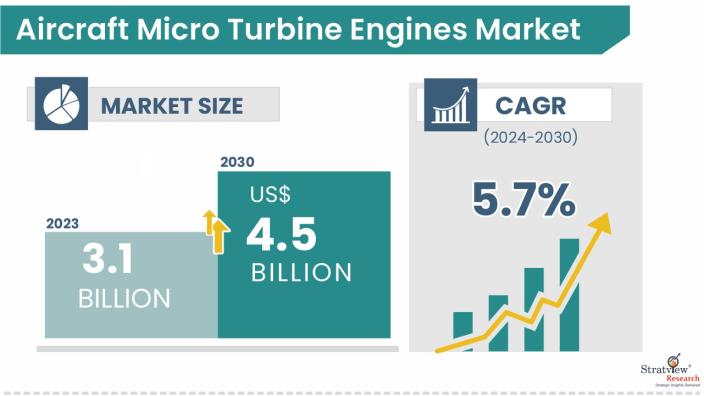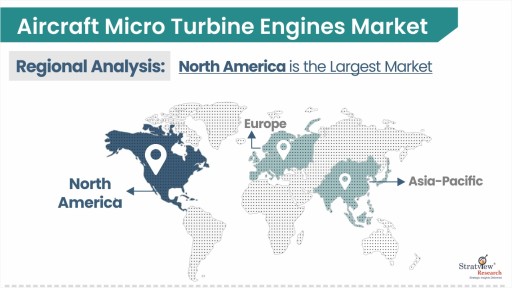Aircraft Micro Turbine Engines Market Insights
The aircraft micro turbine engines market was estimated at USD 3.1 billion in 2023 and is likely to grow at a CAGR of 5.7% during 2024-2030 to reach USD 4.5 billion in 2030.

Want to get a free sample? Register Here
Market Dynamics
Introduction
The aircraft microturbine engines market deals with the key industry of designing, producing, and marketing of small-scale gas turbine engines used in aviation, such as UAVs, light aircraft, military drones, and experimental aircraft. These microturbine engines are highly rated due to their small sizes, low weight, high fuel-to-air ratios, and flexibility in their fuel type, where they can use jet fuel, diesel, or natural gas. Because of their low emissions, as well as low maintenance requirements because the machines have fewer moving parts, GLMs are becoming increasingly popular in present-day flying. The market is propelled by the increased usage of UAVs in military, surveillance, and other civil purposes; increased defense spending; and innovative improvements in the engine section. The extended use of microturbines is attributed to the requirement of lightweight efficiency in the propulsion systems of an aircraft. Furthermore, increased demand for UAVs in civil applications in delivery services, aerial surveys, precision agriculture, and others has provided new growth avenues to the market. But there remain risks that hinder the market growth to some extent, which include high installed costs of microturbine engines and stiff competition from electric propulsion systems.
Aircraft Micro Turbine Engines Market Drivers
- Rising Demand for UAVs—Increased use of unmanned aerial vehicles (UAVs) in defense and commercial sectors drives engine demand.
- Shift Toward Lightweight Engines—Growing need for lightweight and compact propulsion systems fuels microturbine turbine adoption.
- Electrification of Aviation—Hybrid-electric aircraft trends are accelerating the integration of microturbines for auxiliary power.
- Growing Defense Budgets—Increased military spending supports the procurement of advanced surveillance and tactical UAVs.
- Technological Advancements—Innovations in fuel efficiency and materials enhance the performance of microturbine engines.
Segments Analysis
|
Segmentations
|
List of Sub-Segments
|
Segments with High Growth Opportunity
|
|
By Installation Type
|
Original Equipment Manufacturers and Aftermarket
|
Original Equipment Manufacturers are expected to dominate.
|
|
By End-Use Type
|
Propulsion and Auxiliary Power
|
Propulsion is expected to dominate among the various forms.
|
|
By Platform Type
|
General Aviation, Commercial Aviation, Military Aviation, and Advanced Air Mobility
|
Military Aviation is expected to dominate among the key segments.
|
|
By Engine Type
|
Turbojet, Turboshaft, and Turboprop
|
Turbojet will dominate the frequency type in the forecast period.
|
|
By Fuel Type
|
Jet Fuel and Multi Fuel
|
Jet Fuel is dominant amongst other segment
|
|
By Region
|
North America, Europe, Asia Pacific, and Rest of the World
|
The North American region is expected to dominate the market in the forecasted period.
|
Installation Insights
“Original Equipment Manufacturers are expected to dominate.”
This is supported by rising demand and the acquisition of fresh UAVs, light aircraft, military drones, etc. OEMs incorporate micro turbine engines at the point of manufacturing of other systems. Increase in research and development of qualitatively superior thrust and the growth of collaborations with aircraft and defense industries also contribute to the demand.
End-Use Insights
“Propulsion is expected to dominate among the various forms.”
The propulsion segment has the greatest market share because micro turbine engines are used mainly to offer power and thrust in Unmanned Aerial Vehicles (UAVs), light aircraft, and military drones. An increased use of UAVs in defense and surveillance as well as in commercial applications to propel microturbine engines. These characteristics, namely low weight of the engine, high fuel efficiency, and durability make micro turbine engines perfect for aircraft purposes.
Platform Insights
“Military Aviation is expected to dominate among the key segments.”
The growth in the number of UAVs and drones required for military purposes as surveillance or reconnaissance vehicles or engagement in combat missions has led to the widespread use of microturbine engines. This is especially the case with consumer military aviation for whom high defense budgets provide funds for new technologies such as better propulsion systems for UAVs and other aircraft. Micro-turbine engines can effectively suit military drones because they have a small size, a high fuel-to-weight ratio, and flexibility to burn a variety of fuels.
Engine Insights
“Turbojet is expected to dominate among the key segments.”
Turbojet engines are common in Unmanned Aerial Vehicles (UAVs) especially for armed forces because of the high thrust/speed ratios in small size. Turbojets are widely used in reconnaissance, surveillance, combat drones, etc., where structural size, performance, efficiency, and volume matter most. Ongoing advancements in the micro turbojet engine reliability and fuel consumption have further strengthened its hold in the market.
Fuel Insights
“Jet Fuel is dominant amongst other segments.”
Jet-A is the most common and readily available fuel type in aviation and is thus the type of fuel used by most micro-turbine engines. Micro turbine engines are mainly intended to run on jet fuel so they ensure high reliability and efficiency. JP-5/JP-8 is widely adopted in the military since it is characterized by high energy density and density at a lower cost at present; moreover, it is well-compatible with UAVs, drones, and light aircraft.
Regional Insights
“The North American region is expected to dominate the market in the forecasted period.”
Based on the UAVs and drones extensively used in military operations across the globe, especially in North America, the microturbine engines market or used extensively in the United States, has a high demand. The defense budget of the region enables the procurement of these and other innovative technologies, such as microturbine engines. The North American region is extremely advanced in aerospace technology and research, crucial players in the aeronautics industry, and universities are pressuring high-end microturbine engines. Currently, there is substantial manufacturing capacity for aviation and defense purposes in the region due to the availability of jet fuel and microturbine engine technologies, which have been integrated into the area substantially.

Want to get a free sample? Register Here
Key Players
The market is highly fragmented with the presence of over 100 players across the region. Most of the major players compete in some of the governing factors including price, service offerings, regional presence, etc. The following are the key players in the aircraft microturbine engines market.
Here is the list of the Top Players (Based on Dominance)
-
Raytheon Technologies Corporation
-
Honeywell International Inc.
-
Kratos Defense & Security Solutions Inc.
-
Safran SA
-
UAV Turbines Inc.
Note: The above list does not necessarily include all the top players of the market.
Are you the leading player in this market? We would love to include your name. Write to us at [email protected]
Research Methodology
This strategic assessment report from Stratview Research provides a comprehensive analysis that reflects today’s aircraft microturbine engine realities and future market possibilities for the forecast period. The report segments and analyzes the market in the most detailed manner in order to provide a panoramic view of the market. The vital data/information provided in the report can play a crucial role for market participants as well as investors in the identification of the low-hanging fruits available in the market as well as to formulate growth strategies to expedite their growth process.
This report offers high-quality insights and is the outcome of a detailed research methodology comprising extensive secondary research, rigorous primary interviews with industry stakeholders, and validation and triangulation with Stratview Research’s internal database and statistical tools. More than 1,000 authenticated secondary sources, such as company annual reports, fact books, press releases, journals, investor presentations, white papers, patents, and articles, have been leveraged to gather the data. We conducted more than 15 detailed primary interviews with market players across the value chain in all four regions and industry experts to obtain both qualitative and quantitative insights.
Report Features
This report provides market intelligence most comprehensively. The report structure has been kept such that it offers maximum business value. It provides critical insights into market dynamics and will enable strategic decision-making for existing market players as well as those willing to enter the market. The following are the key features of the report:
-
Market structure: Overview, industry life cycle analysis, supply chain analysis.
-
Market environment analysis: Growth drivers and constraints, Porter’s five forces analysis, SWOT analysis.
-
Market trend and forecast analysis.
-
Market segment trend and forecast.
-
Competitive landscape and dynamics: Market share, Service portfolio, New Product Launches, etc.
-
COVID-19 impact and its recovery curve.
-
Attractive market segments and associated growth opportunities.
-
Emerging trends.
-
Strategic growth opportunities for the existing and new players.
-
Key success factors.
Market Segmentation
This report studies the market, covering a period of 12 years of trends and forecasts. The report provides detailed insights into the market dynamics to enable informed business decision-making and growth strategy formulation based on the opportunities present in the market.
The aircraft micro turbine engines market is segmented into the following categories:
By Installation Type
By End-Use Type
-
Propulsion
-
Auxiliary Power
By Platform Type
-
General Aviation
-
Commercial Aviation
-
Military Aviation
-
Advanced Air Mobility
By Engine Type
-
Turbojet
-
Turboshaft
-
Turboprop
By Fuel Type
By Region
-
North America (Country Analysis: The USA, Canada, and Mexico)
-
Europe (Country Analysis: Germany, France, The UK, Russia, and the Rest of Europe)
-
Asia-Pacific (Country Analysis: Japan, China, India, and Rest of Asia-Pacific)
-
Rest of the World (Country Analysis: Brazil, Saudi Arabia, and Others)
Report Customization Options
With this detailed report, Stratview Research offers one of the following free customization options to our respectable clients:
Company Profiling
- Detailed profiling of additional market players (up to three players)
- SWOT analysis of key players (up to three players)
Competitive Benchmarking
- Benchmarking of key players on the following parameters: Service portfolio, geographical reach, regional presence, and strategic alliances
Custom Research: Stratview Research offers custom research services across sectors. In case of any custom research requirement related to market assessment, competitive benchmarking, sourcing and procurement, target screening, and others, please send your inquiry to [email protected]

